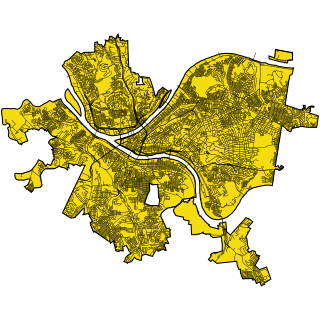Source:Persons-and-things/content
Among the many odd and old-time phases of life in Pittsburgh, almost lost sight of these days, is existence in Chicken alley. What? Never heard of Chicken alley? Well; you are young. Yet that is scarcely an excuse, for Chicken alley is still in existence, even although the bleody [sic] scenes once enacted there with fearful regularity are now spasmodic and tame. There is little left to induce people to stay up until 1 o'clock on a market morning to see the killing. But it was worth while once.
As one walks Diamond street from Wood toward the market house what would first appear to be a private entry is passed. An exploration of its dark and noisome lengths will, however, reveal a small court, almost square and very squalid. Low-windowed houses open on either side, and it requires a second look to determine whether they are the habitation of man or beast. The court is laid in brick, but the drainage is faulty, and stagnant pools of water and offal stand around. In one end is a long wooden rack. It consists principally of a strip on which are numerous hooks, hinged to which is a lattice rack or lid, and below which is a trough. The hooks, the slats, the trough and everything around are stained black with dried blood, in which soiled feathers are sticking. This is the guillotine, the gibbet, the block, or whatever you choose to call it, on which innumerable thousands of squirming fowl have let their life blood out. This smelling, gore-stained place is Chicken alley.
⸻
Rapid refrigerator car transit and the gradual discouragement of shipping live fowl long distances have led to the degeneracy of Chicken alley and its carnage. Time was when all the meat stands in the Pittsburgh Market got their supplies of dressed fowl from it. The fowls were brought in by the farmers or by rail and here slain by the thousands and tens of thousands without respect to feather or family. Those ancient slayers of chickens were adepts at the art, and it was a caution to bed-ticks the way the feathers used to fly. A hundred chickens were strung, head downward, along this rack. The rails held them in position, and their necks were nicely in line above the trough. A sharp knife was run along the line, and another crop of clucks and cackles was harvested. As soon as the fowls had bled sufficiently—or perhaps before—they were taken down and dumped, by armfuls, into hot water. The feathers were stripped off by nimble fingers, the vicera [sic] removed, and the chicken, being thoroughly undressed, was dressed, and ready for the market.
There were some famous sights to be seen in Chicken alley those days. The only requisites to admission and standing room through the whole show were a dull sense of smell and a strong stomach. If both these were possessed the onlooker was well repaid for a bloody shirt and other post-bellum relics.
There was a half-dozen families engaged in chicken killing those days. The word families is used correctly, for no member of a Chicken alley man's flock was exempt from duty. Men and women, old and young; children, grandmothers, sages and prophets, all had some portion of the work assigned them. If they couldn't kill, pick or clean the fowls they could carry them to and from the rack or sweep away he [sic] offal. The work was always done by darkness, and a couple of large gasoline lamps were the nearest approach to light then thought of. The sight of the blood-stained chicken slayers darting about at their work, the chattering of the women, the din of the children, and above all the frightful good-bye squalling of the doomed fowls is described by certain oldtimers as unique in the extreme. So closely was the place hemmed in by high walls and the darkness that very few knew of its existence.
⸻
A good story is told of a well-known lawyer who, being a consistent Good Templar now, must be nameless. One Saturday morning, after a jolly wine supper, he wandered down Diamond street in an aimless and won't-go-home-'till-morning fashion. The orgies were at their height in Chicken alley. As he passed the entry, attracted by the light and noise, he ambled in. Suddenly, like an awful revelation of doom, the scene opened up before him. He paused, petrified.
"Thith ith hell!" he murmured, when at length he found his very thick tongue. "I nevah believed 'n it 'fore; but I wish I had; 'twould kind o' p-e-r-pared me for t-this!" and he was about to sink on his knees when, out in the court, the rack was suddenly brought down on a hundred good country-grown pullets. There was a concentrated squall that could be heard for squares.
Even in his befuddled condition the lawyer recognized that sound, and it came to him as sweetly as the song of birds.
"'Tain't hell," he murmured, as he groped his way out of the entry, "but it's a h⸺l of a big hen coop!"
⸻
There was a great deal that was objectionable about Chicken alley as it used to be, and the probabilities are the health authorities would have ended its career if new market facilities had not. Families were huddled together in the little rooms like sheep in a pen, and the stench arising from the slaughterings was frightful. The drainage being bad and the men indifferent to health, the accumulation of filth would often reach the pestilential period. Chicken alley, like some other of Pittsburgh's provincialisms, had better remain a fragrant flower of remembrance.
